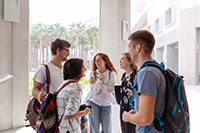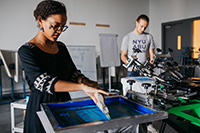-
Academics
-
Admissions
 Your journey to NYUAD starts here. Attend an application workshop or information session.Admissions Events
Your journey to NYUAD starts here. Attend an application workshop or information session.Admissions Events -
Research
-
Campus Life
 Live the possibilities. Be part of a dynamic community of students from over 115 countries.Take a Tour
Live the possibilities. Be part of a dynamic community of students from over 115 countries.Take a Tour - Public Programs
-
About
Exceptional education. World class research. Community-driven.Our Story
- News
- Events
- Social Media Directory
- Press Room
-
- Torch at NYUAD
- Faculty
- Current Students
- Alumni
- عربي
Chemical and Functional Genomics
The chemical genomics lab focuses on the discovery and characterization of biologically active molecules and their mode of action. The discovery of new potential disease therapeutics (e.g. anti-cancer, antimicrobials) and broad-spectrum anthelmintics (to target parasitic worms, which affect 24% of humans, crops, and livestock) remains a challenge. The chemical genomics team has developed an advanced robotics platform and workflows for high-throughput screening using simple animal models and powerful high-content cell-based screening assays. Using this platform, the team has screened small molecule and drug libraries in both mammalian cells and whole organisms (e.g. microbes, worms). Candidates are sourced from both small molecule libraries and natural products, with a focus on microbes collected from the unique ecosystems in the Arabian Gulf and across the region.
The anthelmintic discovery project involves assaying for lethality or developmental phenotypes in two distantly related free-living nematode species, C. elegans and P. pacificus. Activity in both species is an indicator of potential broad-spectrum anthelmintic activity, based on the observation that these laboratory models are susceptible to most known drugs currently used to treat infections by parasitic nematodes.
The team is also investigating the use of biopesticides to fight both nematode infections and the Red Palm Weevil pest, a major threat for the UAE palm trees. Bacillus thuringiensis is a soil bacterium that harbors a variety of toxins against different families of insects and nematodes. The best-characterized Bt toxins are produced during sporulation in parasporal crystals and are thus called Crystal proteins (Cry). Due to their apparent species-specificity and safety to humans, Bt-expressing Cry proteins are attractive biocontrol agents and have become the most widely used biopesticides in organic farming today.
Natural products are valuable sources of bioactive drugs: over the past 25 years, over two thirds of FDA-approved drugs are either natural products or compounds derived from them. Our team is surveying natural products produced by marine microbes in the Abu Dhabi region, a largely untapped resource expected to be rich in bioactive chemicals. We have isolated around 300 bacterial strains from different habitats in the Abu Dhabi region and have established protocols for culturing and fractionating extracts from these bacterial strains. The aim of this work is to identify novel compounds with broad-spectrum activity against parasitic worms, bacterial or fungal infections, as well as biomarkers or bioactivity in mammalian cell models. We are applying High-Throughput (HTP) screening of whole organisms (e.g. nematodes) and High-Content Phenotypic profiling (HCP) of mammalian cells to identify and characterize novel compounds. Our automated discovery platform enables rapid screening of isolated compounds for their anti-cancer, anthelmintic, antibiotic and antifungal effects. We are also developing and applying state of the art methods for cytological profiling, chemical genetics, molecular diagnostics, and computational approaches to identify putative mechanisms of action. This work will expand the repertoire of known bioactive compounds and their molecular targets for basic and applied biomedical research.
Learn more about Kristin Gunsalus's NYU Lab.
Principal Investigator
Co-Principal Investigators
Researchers
Visiting Scholar
Glenn Butterfoss
ProteinQure
Xin Xie
Shaoxing University
Antony Page
University of Glasgow






